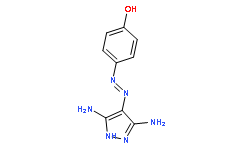| Cas No.: | 140651-18-9 |
| Chemical Name: | Phenol, 4-[(3,5-diamino-1H-pyrazol-4-yl)azo]- |
| SMILES: | OC1=CC=C(C=C1)\N=N\C2C(N)=NNC=2N |
| Formula: | C9H10N6O |
| M.Wt: | 218.22 |
| Purity: | >98% |
| Sotrage: | 2 years -20°C Powder, 2 weeks 4°C in DMSO, 6 months -80°C in DMSO |
| Description: | CAN508 is a potent, ATP-competitive CDK9/cyclin T1 inhibitor with an IC50 of 0.35 μM. CAN508 exhibits a 38-fold selectivity for CDK9/cyclin T over other CDK/cyclin complexes. Antitumor activity[1][2]. |
| Target: | CDK9/cyclinT1:0.35 μM (IC50) CDK2/cyclinE:20 μM (IC50) cdk2/cyclin A:69 μM (IC50) Cdk4/cyclin D1:13.5 μM (IC50) CDK7/cyclin H:26 μM (IC50) Cdk1/cyclin B:44 μM (IC50) |
| In Vivo: | CAN508 (60 mg/kg; i.p.; daily for 10 days) has antitumor effects in esophageal adenocarcinoma xenografts[1]. Animal Model: 4 weeks-old female nude mice (esophageal adenocarcinoma xenografts)[1] Dosage: 60 mg/kg Administration: I.p.; daily for 10 days Result: Caused reduction of tumor growth starting from post-treatment day three with 50.83% reduction. |
| In Vitro: | CAN508 reduces the frequency of S-phase cells of the cancer cell line HT-29 in antiproliferation assays[1]. CAN508 (20-40 μM; 72 hours) significantly reduces cell proliferation in a dose dependent manner in all three esophageal adenocarcinoma cell lines (SKGT4, OE33 and FLO-1 cells) with IC50s ranging from 34.99 to 91.09 μM[2]. CAN508 (40 μM; 72 hours) increases apoptosis in all three esophageal adenocarcinoma cells[2]. Apoptosis Analysis[1] Cell Line: SKGT4, OE33 and FLO-1 cells Concentration: 40 μM Incubation Time: 72 hours Result: Increased apoptosis by 2 fold in all three esophageal adenocarcinoma cells compared to untreated controls. |
| References: | [1]. Krystof V, et al. 4-arylazo-3,5-diamino-1H-pyrazole CDK inhibitors: SAR study, crystal structure in complex with CDK2, selectivity, and cellular effects. J Med Chem. 2006;49(22):6500-6509. [2]. Tong Z, et al. Antitumor effects of cyclin dependent kinase 9 inhibition in esophageal adenocarcinoma. Oncotarget. 2017;8(17):28696-28710. |

 To enhance service speed and avoid tariff delays, we've opened a US warehouse. All US orders ship directly from our US facility.
To enhance service speed and avoid tariff delays, we've opened a US warehouse. All US orders ship directly from our US facility.




















